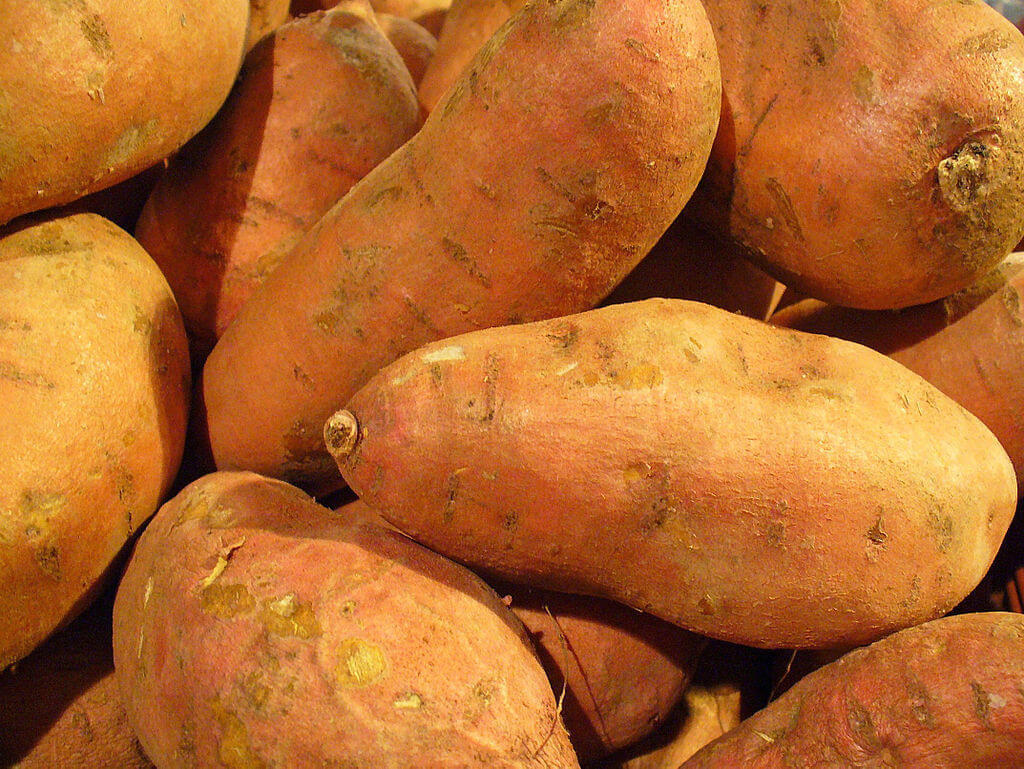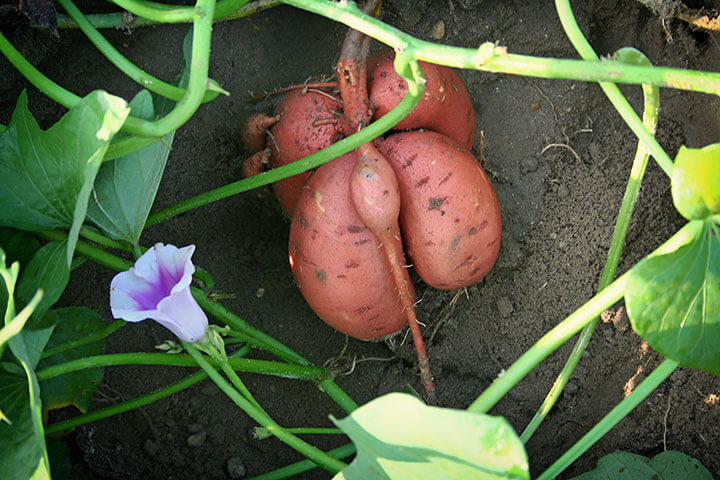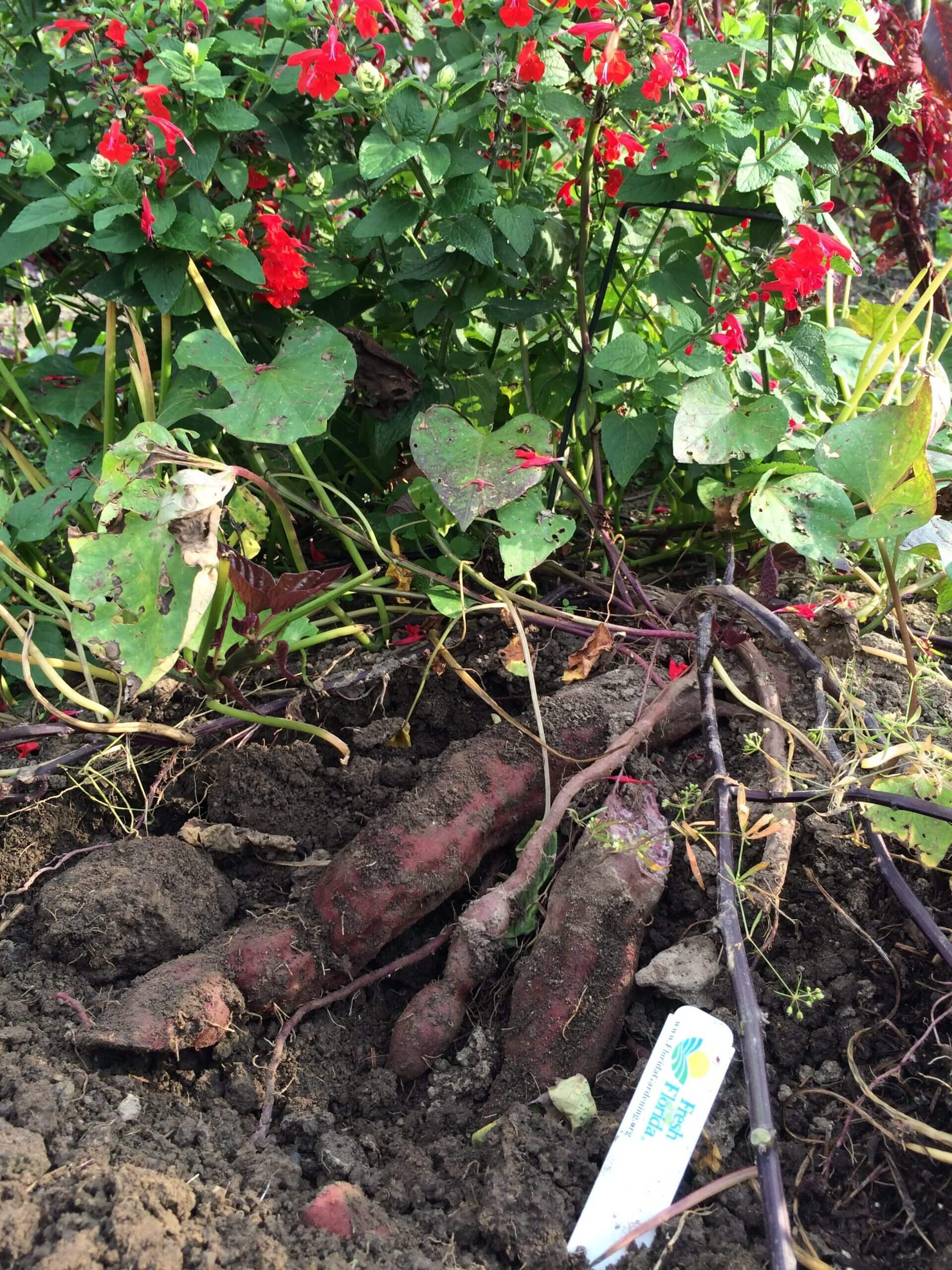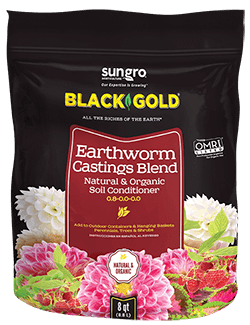
Since North Carolina leads the nation in sweet potato (Ipomoea batatas) production, and I have lived in the Old North State for 33 years, you would think that I would know a thing or two about growing edible sweet potatoes – this essential staple of Southern cuisine.
Honestly, the only edible sweet potatoes I have planted have been in our window box – partly as a science experiment for my children, and to a certain extent for my own amusement. The rusty-orange tapered tubers were impaled midway round with three wooden toothpicks. This arrangement was perfect for suspending the sweet potatoes so that they were only partially submerged in a glass of water. In a short time, tiny roots would begin emerging underwater, followed later by curvaceous stems sprouting from the top and sides above the toothpicks. Within a month, these soggy-bottomed sweet potatoes would rival any Pothos, but we usually composted them when they began climbing the curtains.

So, to learn how to plant edible sweet potatoes in my home garden, I went to the experts at The North Carolina Sweet Potato Commission. (Check their website for a complete list of this culinary treasure’s nutritional benefits and a bevy of mouth-watering recipes.) The NCSPC suggests that to fully understand sweet potato culture, it helps to first learn what a sweet ‘tater is, and is not.
Ipomoea batatas is a tropical plant indigenous to Polynesia as well as Central and South America, so it needs about 150 frost-free days to develop, then a couple more weeks of exposure to temperatures above 85 degrees Fahrenheit paired with high humidity to cure (we will get to that process later). This is exactly why they grow so well in the South.
The sweet tapered tuber we so enjoy baked, fried, grated, and mashed comes in various shades of orange, white, and purple. And, even though it is related to poisonous Morning Glories, the young shoots and leaves of sweet potatoes are edible.
It is not a Yam. Though sweet potatoes are often traditionally labeled “yams”, a true yam is a white-fleshed and fibrous tuber from Africa. Check the next can of yams you see in your grocery store for the words “Sweet Potatoes” on the ingredients list.
Let’s get growing!

The North Carolina Sweet Potato Commission’s step-by-step guide for home gardeners, “Sweet Potatoes 101”, explained that the beginning of the grow-your-own process is exactly what I had already been doing in my window box!
I could have simply harvested those sprouts with leaves by cutting or twisting them off the tuberous root when the shoots were only about 8-10 inches long, then planted them directly into my garden.
The directions state that transplanted sweet potato sprouts need “well-drained, sandy, loamy soil”, but I have red clay. So, it would be to my advantage to either plant the shoots into large black plastic pots filled with Black Gold Natural and Organic Potting Soil, or directly in the garden in rows amended with Black Gold Earthworm Castings after the last chance of frost. The organic fertilizer amendments already present in the Black Gold potting medium and soil conditioner would certainly help feed developing underground tuberous roots.

“Plant sprouts 9 to 10 inches apart in the center of the ridge row and at a depth of 3 inches with at least 2 plant nodes underground and 2 or more leaves above ground,” continues the NCSP’s recommendations. Then, “Water well immediately after transplanting.” Since they are hardier than many vegetables, only regular watering, and simple weed and pest maintenance is required.
Then comes the reward. “Sweet potato roots are harvested 90-120 days after transplanting or immediately after a frost has blackened the tops of the plants,” advises the NCSPC.
“With gloves and a shovel, carefully remove sweet potatoes from the soil. Handle them carefully as their skin is thin and will bruise easily. Do not leave the sweet potatoes exposed to direct sunlight for more than 30 minutes or they will sunscald and be more susceptible to rotting during storage.”
Now, to make it even sweeter…

One Saturday morning while shopping at our local farmer’s market, I overheard a young lady peddling her sweet potatoes to a potential customer. She was singing the praises of her crop, adding that her sweet potatoes had been properly cured. Her alarmed customer asked anxiously, “Cured of what?”
“Curing” is an old farming term for the final step in processing. A sweet potato’s skin heals through curing while its natural starches convert to sugars, greatly improving its final taste. Even George Washington cured his sweet potatoes.
The North Carolina Sweet Potato Commission instructs that after harvesting, “Away from direct sunlight, spread the sweet potatoes out to dry for several hours. Once dry, put them in a newspaper-lined box and leave them in a dry, ventilated area for 2 weeks.”
“Once cured, store in a cool, dry place until ready to cook. Sweet potatoes can be stored for up to 10 months with little reduction in quality.”
My children are now grown and have moved away, but the window box will soon host a variety of edible sweet potatoes poised in glasses of water. And, if I grow a successful crop in my garden this summer, I will proudly serve my own homemade and homegrown sweet potato casserole when the kids come to visit at Thanksgiving.
